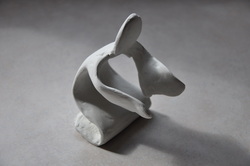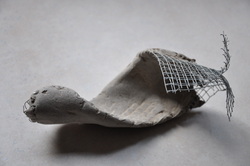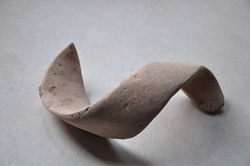This second "create and donate" piece will be for public display so must be large and tough enough to withstand some abuse. Who to offer it to? The GYMC (Guelph Youth Music Centre) came to mind because I support their mission and love their architecture. A few emails later Brenda Gibson, the Executive Director met with me to discuss possible ideas and locations. We opted for a floor piece of a dancer standing upright with hands extending high, about 2 metres tall, preferably bronze colour. Stones such as alabaster would be so heavy in this size that I'd need a crane to move it around. Cast bronze would also be too heavy and expensive for this project but I thought I could find a suitable alternative and either tint it, stain it, coat it or paint it.
Off to the Sculture Supply store in Toronto Pam and I headed for a shopping adventure. After listening to their expert explain possible mediums, we opted for Winterstone, a product that behaves like clay when first mixed, hardens after one day to be carved like a soft stone then cures after several more days to be as hard as concrete. The surface can be finished or painted in many ways to looks like fired clay, glazed clay, natural stone or metal. The sculpture is created by carving a foam core and covering it with wire mesh then applying Winterstone over the top. More layers are added along with fabric mesh for strength and shaped as needed to build the desired base. An icing coat containing tint or metal dust is applied to achieve the final shape. When I asked about how much it would cost to use bronze dust for the GYMC sculpture the expert would only say pricey, very pricey so that option is out for now.
We bought enough supplies to conduct some trials and will return for more purchases once I have a better understanding of what is needed. The planned finish was to be created by chemically staining the hardened Winterstone surface but once we were home and read the warnings about acid, environmental and cancerous risks we returned the product and purchased two tints, raw umber and desert tan instead.



The Rotarty Club of Guelph meeting happened to be at the GYMC this week so I took the three test samples along with me to see which best suited the room decor. White would be wonderful but tends to invite unwanted graffiti and will look dirty over time. Theoretically Winterstone lasts about a hundred years so cleaning will undoubtedly be required throughout its life. The desert tan colour conflicts with the present wall colour in the display room so is out as an option for this sculpture. The raw umber will contrast the wall colour nicely, be easily viewed from the angle with a window behind the sculpture and complement the dark pipe infrastructure along the ceiling. I decided to proceed with raw umber as the best choice when making the scale model. We can always switch to a different tint for the full size sculpture. The backup plan is to paint it bronze but we all know that paint looks great at the start then needs to be reapplied every five or ten years.
 RSS Feed
RSS Feed
